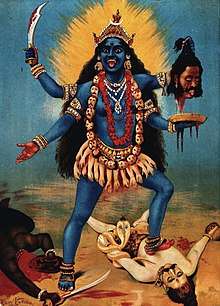Matrikas
Matrikas (singular Matrika, Sanskrit: मातृका, IAST: mātṝkā, lit. "divine mother")[2] also called Matar or Matri, are a group of mother goddesses who are always depicted together in Hinduism. Matrikas are the different forms Adi Parashakti. Matrikas are the personified powers of different Devas. Brahmani emerged from Brahma, Vaishnavi from Vishnu, Maheshvari from Shiva, Indrani from Indra, Kaumari from Skanda, Varahi from Varaha and Chamunda from Devi,[3] and additionals are Narasimhi, Vinayaki.
| Matrikas | |
|---|---|
Goddesses of War, Children and Emancipation.[1] | |
_Flanked_by_Shiva_(left)_and_Ganesha_(right).jpg) The Seven Mother Goddesses (Matrikas) Flanked by Shiva (left) and Ganesha (right) | |
| Devanagari | मातृका |
| Sanskrit transliteration | mātṝkā |
| Affiliation | Shakti , Devi, Mahadevi, Adi parashakti, Parvati, Saraswati, Lakshmi |
| Abode | Inside the body of different Gods as their spouses or energies(shaktis) |
| Consort | Ashta Bhairavas or Different gods |
| Part of a series on |
| Shaktism |
|---|
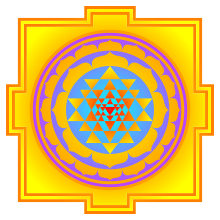 |
|
Schools |
|
Festivals and temples |
|
|
The Matrikas are usually depicted in a group of seven called Saptamatrika(s) (Seven Mothers).[4] However, they may be eight Matrikas called Ashtamatrika(s).[5] In South India, Saptamatrika worship is prevalent whereas the Ashtamatrika are venerated in Nepal.[6]
The Matrikas assume paramount significance in the goddess-oriented sect of Hinduism, Tantrism.[7] In Shaktism, they are described as "assisting the great Shakta Devi (goddess) in her fight with demons."[8] Some scholars consider them Shaiva goddesses.[9] They are also connected with the worship of warrior god Skanda.[10] In most early references, the Matrikas are described as having inauspicious qualities and often described as dangerous.The Matrikas are fearsome goddesses, abductors and eaters of children; that is, they were emblematic of childhood pestilence, fever, starvation, and disease. They were propitiated in order to avoid those ills, that carried off so many children before they reached adulthood.[11] They come to play a protective role in later mythology, although some of their inauspicious and wild characteristics still persist in these accounts.[12] Thus, they represent the prodigiously fecund aspect of nature as well as its destructive force aspect.[13]
In the Brihat-Samhita, Varahamihira says that "Mothers are to be made with cognizance of (different major Hindu) gods corresponding to their names."[14] They are associated with these gods as their spouses or their energies (Shaktis).[13] Originally believed to be a personification of the seven stars of the star cluster the Pleiades, they became quite popular by the seventh century and a standard feature of goddess temples from the ninth century onwards.[15]
Origins and development
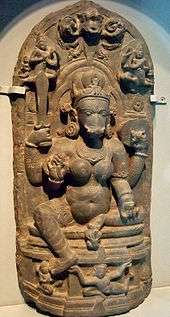
According to Jagdish Narain Tiwari and Dilip Chakravati, the Matrikas were existent as early as the Vedic period and the Indus Valley civilization. Seals with rows of seven feminine deities or priestesses are cited as evidence for the theory.[16][17] The Rigveda (IX 102.4) speaks of a group of seven Mothers who control the preparation of Soma, but the earliest clear description appears in select chapters of the epic Mahabharata dated to 1st century AD.[18][19] Wangu believes that Matrika description in Mahabharata is rooted in the group of seven females depicted on Indus valley seals.[7] It was assumed that the people locally worshipped these goddesses, such an example is also described in Zimmer Heinrich book The Art Of Indian Asia, about the seven shrines of seven Mother Goddesses worshipped locally.
By the fifth century, all these goddesses were incorporated in mainstream orthodox Hinduism as Tantric deities.[20][21] David Kinsley proposes that the Matrikas may be non-Aryan or at least non-Brahmanical (orthodox Hinduism), local village goddesses, who were being assimilated in the mainstream. He cites two reasons for his assertion: their description in Mahabharata as dark in colour, speaking foreign languages and living in "peripheral areas" and their association with non-Brahmanical god Skanda and his father, Shiva, who though Vedic has non-Brahmanical attributes.[22] Sara L. Schastok suggests that the Matrikas maybe inspired by the concept of Yakshas, who are associated with Skanda and Kubera – both are often portrayed with the Matrikas.[23] In contrast to Indus valley origins theory, Bhattacharyya notes:
The cult of the Female Principle was a major aspect of Dravidian religion, The concept of Shakti was an integral part of their religion [...] The cult of the Sapta Matrika, or Seven Divine Mothers, which is an integral part of the Shakta religion, may be of Dravidian inspiration.[24]
The Sapta-Matrikas were earlier connected with Skanda (Kumara) and in later times, associated with the sect of Shiva himself.[10] During the Kushana period (1st to 3rd century), the sculptural images of the matrikas first appear in stone. The Kushana images merged from the belief in Balagraha (lit "destroyers of children") worship related to conception, birth, diseases and protection of children. The Balagraha tradition included the worship of the infant Skanda with the Matrikas. The goddesses were considered as personifications of perils, related to children and thus, were pacified by worship. The Kushana images emphasize the maternal as well as destructive characteristics of the Matrikas through their emblems and weapons. They appear to be an undifferentiated sculptural group but develop in standard and complex iconographic representation during the following Gupta period.[25]
In the Gupta period (3rd to 6th century A.D.), folk images of Matrikas became important in villages.[26] The diverse folk goddesses of the soldiers like Matrikas were acknowledged by the Gupta rulers and their images were carved on royal monuments in order to strengthen the loyalty and adherence of the armed forces.[27] The Gupta kings Skandagupta and Kumaragupta I (c. second half of fifth century) made Skanda (Kumara)[b] their model and elevated the position of Skanda's foster mothers, the Matrikas from a cluster of folk goddesses to court goddesses.[28] Since the fourth century, Parhari, Madhya Pradesh had a rock-cut shrine been solely devoted to the Sapta Matrika.[29]
The Western Ganga Dynasty (350–1000 CE) kings of Karnataka built many Hindu temples along with saptamatrika carvings[30] and memorials, containing sculptural details of saptamatrikas.[31] The evidence of Matrika sculptures is further pronounced in the Gurjara–Patiharas (8th to 10th century A.D.) and Chandella period (8th to 12th century A.D.).[32] The Chalukyas claimed to have been nursed by the Sapta Matrikas. It was a popular practice to link South Indian royal family lineage to a Northern kingdom in ancient times.[33] During the Chalukya period (11th to 13th century), all Matrikas continued to figure among the deity sculptures of this period.
The Kadambas and Early Chalukyas from the fifth century praise the Matrikas in their preambles, as giver of powers to defeat enemies.[34][35] In most of the relevant texts, their exact number has not been specified, but gradually their number and names became increasingly crystallized and seven goddesses were identified as matrikas, albeit some references indicate eight or even sixteen Matrikas.[36] Laura K. Amazzone cites:
The inconsistency in the number of Matrikas found in the valley [Indus] today (seven, eight, or nine) possibly reflects the localization of goddesses [.] Although the Matrikas are mostly grouped as seven goddesses over the rest of the Indian Subcontinent, an eighth Matrikas has sometimes been added in Nepal to represent the eight cardinal directions. In Bhaktapur, a city in the Kathmandu Valley, a ninth Matrika is added to the set to represent the center.[37]
Iconography
The iconographical features of the Matrikas have been described in Hindu scriptures such as the Mahabharata, Puranas such as the Varaha Purana, Agni Purana,[38] Matsya Purana, Vishnudharmottara Purana and Devi Mahatmya (part of the Markandeya Purana) and also in the Agamas such as the Amsumadbhedagama, Surabhedagama, Purvakarnagama and Rupamandana.
The Ashta-Matrikas as described in the Devi Mahatmya[39]
- Brahmani (Sanskrit: ब्रह्माणी, Brahmâṇī) or Brahmi (Sanskrit: ब्राह्मि, Brāhmī) is the Shakti (power) of the creator god Brahma. She is depicted yellow in colour and with four heads. She may be depicted with four or six arms. Like Brahma, she holds a rosary or noose and kamandalu (water pot) or lotus stalk or a book or bell and is seated on a hamsa (identified with a swan or goose) as her vahana (mount or vehicle). She is also shown seated on a lotus with the hamsa on her banner. She wears various ornaments and is distinguished by her basket-shaped crown called karaṇḍa mukuṭa.
- Vaishnavi (Sanskrit: वैष्णवी, Vaiṣṇavī), the power of the preserver-god Vishnu, is described as seated on the Garuda (eagle-man) and having four or six arms. She holds Shankha (conch), chakra (Discus), mace and lotus and bow and sword or her two arms are in varada mudra (Blessing hand gesture) and abhaya mudra ("No-fear" hand gesture). Like Vishnu, she is heavily adorned with ornaments like necklaces, anklets, earrings, bangles etc. and a cylindrical crown called kiriṭa mukuṭa.
- Maheshvari (Sanskrit: महेश्वरि, Māheśvarī) is the power of god Shiva, also known as Maheshvara. Maheshvari is also known by the names Raudri, Rudrani, Maheshi and Shivani derived from Shiva's names Rudra, Mahesha, and Shiva. Maheshvari is depicted seated on Nandi (the bull) and has four or six hands. The white complexioned, Trinetra (three eyed) goddess holds a Trishula (trident), Damaru (drum), Akshamala (A garland of beads), Panapatra (drinking vessel) or axe or an antelope or a kapala (skull-bowl) or a serpent and is adorned with serpent bracelets, the crescent moon and the jaṭā mukuṭa (A headdress formed of piled, matted hair).
- Indrani (Sanskrit: इन्द्राणी, Indrāṇī), also known as Aindri, (Sanskrit: ऐन्द्री, Aindrī), Mahendri and Vajri, is the power of the Indra, the Lord of the heaven. Seated on a charging elephant, Aindri, is depicted dark-skinned, with two or four or six arms. She is depicted as having two or three or like Indra, a thousand eyes. She is armed with the Vajra (thunderbolt), goad, noose and lotus stalk. Adorned with variety of ornaments, she wears the kiriṭa mukuṭa.
- Kaumari (Sanskrit: कौमारी, Kaumarī), also known as Kumari, Kartiki, Karttikeyani and Ambika[40] is the power of Kumara (Kartikeya or Skanda), the god of war. Kaumari rides a peacock and has four or twelve arms. She holds a spear, axe, a Shakti (power) or Tanka (silver coins) and bow. She is sometimes depicted six-headed like Kumara and wears the cylindrical crown. In Tamil Nadu, Karumari Amman is a favored deity and is popularly worshipped in many temples.
- Varahi (Sanskrit: वाराही, Vārāhī) or Vairali is described as the power of Varaha – the boar-headed form of Vishnu. She holds a Danda (rod of punishment) or plough, goad, a Vajra or a sword, and a Panapatra. Sometimes, she carries a bell, chakra, chamara (a yak's tail) and a bow. She wears a crown called karaṇḍa mukuṭa with other ornaments.
- Chamunda (Sanskrit: चामुण्डा, Cāṃuṇḍā), also known as Chamundi and Charchika is the power of Devi (Chandi). She is very often identified with Kali and is similar in her appearance and habit.[41] The identification with Kali is explicit in Devi Mahatmya.[42] The black coloured Chamunda is described as wearing a garland of severed heads or skulls (Mundamala) and holding a Damaru (drum), trishula (trident), sword and pānapātra (drinking-vessel). Riding a jackal or standing on a corpse of a man (shava or preta), she is described as having three eyes, a terrifying face and a sunken belly.
- Pratyangira (Sanskrit: नारसिंहीं, Nārasiṃhī), also known as Narasimhika, is the power of Narasimha (lion-man form of Vishnu). She is a woman-lion goddess who throws the stars into disarray by shaking her lion mane.
Though the first six are unanimously accepted by texts, the name and features of the seventh and eighth Matrika are disputed. In Devi-Mahatmya, Chamunda is omitted after the Saptamatrika list,[43] while in sculpture in shrines or caves and the Mahabharata, Narasimhi is omitted. The Varaha Purana names Yami – the Shakti of Yama, as the seventh and Yogishwari as the eighth Matrika, created by flames emerging from Shiva's mouth.[44] In Nepal, the eighth Matrika is called Maha Lakshmi or Lakshmi is added omitting Narasimhi. In lists of nine Matrikas, Devi-Purana mentions Gananayika or Vinayaki – the Shakti of Ganesha, characterized by her elephant head and ability to remove obstacles like Ganesha and Mahabharavi omitting Narasimhi. The Female power Shakti of Lord Matasya is also included sometimes in central India. Devi bhagwatam mentions 2 other Matrikas Varuni(shakti of Varuna) and Kauberi (shakti of Kubera).[45]
Legends
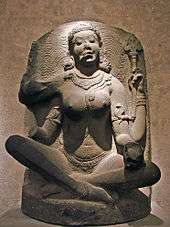
There are several Puranic texts related to the origin of Matrikas. Matsya Purana, Vamana Purana, Varaha Purana, Kurma Purana and the Suprabhedagama contain references to Matrikas, and this asserts their antiquity.[46]
According to the Shumbha-Nishumbha story of Devi Mahatmya, Matrikas appear as Shaktis from the bodies of the gods – Brahma, Shiva, Skanda, Vishnu, Indra;[47] having form of each, approached Chandika (identified with Devi) with whatever form, ornaments and vehicle the god possessed. In that form, they slaughter the demon army.[9][48] Thus, the Matrikas are goddesses of the battlefield. They are described as assistants of Durga having sinister as well as propitious characteristics.[42] After the battle, the Matrikas dance drunk with their victim's blood.[49] This description is repeated with little variation in Devi Bhagavata Purana.[50] and Vamana Purana.[51] The Devi-Bhagavata Purana mentions three other goddesses, Shaktis of other gods in addition to Saptamatrikas making a group of 10 Matrikas.[52]
According to latter episode of Devi Mahatmya, Durga created Matrikas from herself and with their help slaughtered the demon army. In this version, Kali is described as a Matrika, who sucked all the blood of demon Raktabija. Kali is given the epithet Chamunda in the text. When demon Shumbha challenges Durga to a single combat, she absorbs the Matrikas in herself and says that they are her different forms.[53] In the Vamana Purana too, the Matrikas arise from different parts of Devi and not from male gods although they are described and named after the male deities.[54]
In Matsya Purana, Shiva had created seven Matrikas to combat the demon Andhaka, who had the ability to duplicate from each drop of his blood that falls from him when he is wounded.[c] The Matrikas drink up his blood and help Shiva defeat the demon. After the battle, the Matrikas begin a rampage of destruction by starting to devour other gods, demons and peoples of the world. Narasimha, Vishnu's man-lion incarnation, creates a host of thirty-two benign goddesses who calm down the terrible, fire-breathing Matrikas. Narasimha commanded the Matrikas to protect the world, instead of destroying it and thus be worshipped by mankind. At the end of the episode, Shiva's terrible form Bhairava is enshrined with the images of the Matrikas at the place where the battle took place.[55][56] This story is retold in Vishnudharmottara Purana.[57] Vishnudharmottara Purana further relates them with vices or inauspicious emotions like envy, pride, anger etc.[58]
In Varaha Purana, they are created from the distracted mind of goddess Vaishnavi, who loses her concentration while doing asceticism. They are described as lovely and act as the goddesses' attendants on the battlefield.[59] In Bhagavata Purana, when beings created by Vishnu are enlisted; the Matrikas are listed with rakshasas (demons), bhutas (ghosts), pretas, dakinis and other dangerous beings. In the same text, milkmaids offer a prayer for protection of the infant-god Krishna from the Matrikas.[60]
The Devi Purana (6th – 10th century) mentions a group of sixteen matrikas and six other types of Matrikas mentioned, apart from the Saptamatrikas.[61] It introduces the Loka-matara (mothers of the world), a term used in the Mahabharata, in the very first chapter. Kind to all creatures, the Matrikas are said to reside in various places for the benefit of children.[62] The text paradoxically describes the Matrikas as being created by various gods like Brahma, Vishnu, Shiva, Indra as well as being their mothers.[63] Devi Purana describe a pentad of Matrikas, who help Ganesha to kill demons.[64] Further, sage Mandavya is described as worshipping the Māṭrpaňcaka (the five mothers) named Ambika (Kaumari), Rudrani, Chamunda, Brahmi and Vaishnavi and who have been established by Brahma; for saving king Harishchandra from calamities. The Matrikas direct the sage to perform worship of Māṭrchakra(interpreted as a Yantra or Mandala or a circular shrine to the Matrikas), established by Vishnu on the Vindhya mountains, by meat and ritual sacrifice.[65]
Mahabharata
The Mahabharata narrates in different chapters the birth of warrior-god Skanda (the son of Shiva and Parvati) and his association with the Matrikas – his adopted mothers.
In one version, Indra (king of gods) sends the goddesses called "mothers of the world" to kill him.[18] However, upon seeing Skanda, instead they follow their maternal instincts and raise him.[7] In the chapter Vana-parva version, the Saptamatrikas are mentioned.[18][66] Later in the Mahabharata; when absorption of these indigenous goddesses in the Brahmanic pantheon was initiated, a standardized group of seven goddesses – the Saptamatrikas, Shaktis or powers of Brahmanic gods are mentioned as Brahmi, Maheshvari, Kumari, Vaishnavi, Varahi, Indrani and Chamunda.[7]
In other accounts of Skanda's birth in Mahabharata, eight ferocious goddesses emerge from Skanda, when struck by Indra's Vajra (thunderbolt). These are Kāki, Halimā, Mālinī, Bṛhalī, Āryā, Palālā and Vaimitrā, which Skanda accepted as his mothers, who stole other children – a characteristic of the Matrikas.[67]
Another account mentions the Maha-matrikas (the great mothers), a group of the wives of six of the Saptarishis (7 great sages), who were accused of being Skanda's real mothers and thus abandoned by their husbands. They request Skanda to adopt them as his mothers. Skanda agrees and grants them two boons: to be worshipped as great goddesses and permission to torment children as long as they are younger than 16 years and then act as their protectors.[67] These six goddesses as well as the Saptamatrikas are identified or associated with Vedic Krittikas, the constellation Pleiades.[68]
The Shalya Parva of the Mahabharata mentions characteristics of a host of Matrikas, who serve Skanda. Ninety-two of them are named but the text says there exist more. The Shalya Parva describes them as young, cheerful, most of them fair but having dangerous features like long nails and large teeth. They are said to fight like Indra in battles, invoking terror in minds of enemies; speak different foreign tongues and lives in inaccessible places away from human settlements like crossroads, caves, mountains, springs, forests, riverbanks and cremation grounds.[69][70][71] Notable among these lists of Matrikas is Putana, a goddess who tried to kill the infant Krishna (an incarnation of Vishnu) by suckling him with poisoned breast milk and consequently killed by Krishna.[72]
Depictions
The textual description of Matrikas is generally frightening and ferocious. In the Mahabharata, all the seven mothers are described as fatal or serve as threats to foetuses or infants. They are described as living in trees, crossroads, caves and funeral grounds and they are terrible as well as beautiful.[7] But, in the sculptural portrayal, they are depicted quite differently as protectors and benevolent mothers. They are armed with the same weapons, wear the same ornaments, and ride the same vahanas and carry the same banners as their corresponding male deities.
The Saptamatrkas are generally carved in relief on a rectangular stone slab in the sequential order of Brahmani, Maheshvari, Kumari, Vaishnavi, Varahi, Indrani and Chamunda, being flanked by two male figures – a terrible form of Shiva (Virabhadra) and his son Ganesha in both sides (first – on their right and last – on their left). Thus, the Matrikas are considered Saivite goddesses.[9] They are often depicted on the lintel slabs of the main door of a Shiva temple – mainly in Jaunsar-Bawar region, with their respective mounts forming the pedestal.[13] Sometimes, they are occupied by the couple Uma-Maheshvara (Parvati and Shiva). The earliest instance of their portrayal with Uma-Maheshvara is at Desha Bhattarika, Nepal although now the Matrika images have withered away.[73] The 12th century Sanskrit author Kalhana mentions worship of Matrikas with Shiva in Kashmir, his work Rajatarangini.[74]
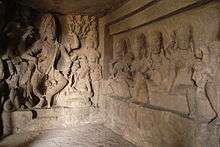
Three panels of Saptamatrikas appear near the Shiva cave at Udayagiri, Bhopal.[75] They are also depicted in the Shaiva caves of Elephanta and Ellora (Caves 21, 14, 16 and 22).[76] In sixth century Rameshvara cave (Cave 21) at Ellora, "With the terrific aspect repressed entirely, the matrikas are depicted as benign and are worshipped in adulation. Sensuous, elegant, tender, beautiful adolescents, they are yet haughty and grand, quintessentially the creatrix."[77] Karrtikkeyi (Kumari) is depicted with a child on her lap and even Varahi is depicted with a human head, rather than the usual boar one.[78] In Ravana-ka-kai cave (Cave 14), each of the matrikas is with a child.[79] In eighth century Kailash Temple (cave 16) – dedicated to Shiva – of Rashtrakuta period, the Matrikas appear on the southern boundary of the temple.[29] As the influence of Tantra rose, the fertility area and upper parts of body in the Matrika sculptures were stressed.[80]
In each of the four depictions at Ellora, the matrikas are accompanied by Virabhadra, Ganesha and also on their left (besides Ganesha) by Kala (Time personified or Death).[81] The presence of Kala in form of a skeleton, seems to indicate the darker aspect of the matrikas' nature.[79] At Osian, the Matrikas is flanked by Ganesha and Kubera (the treasurer of the gods and a devotee of Shiva) while Virabhadra sits in the middle of the group.[82] In Gupta and post-Gupta art, like in 6th Century caves of Shamalaji, the Matrikas are accompanied by Shiva's son Skanda.
Associations
Yoginis
%2C_Kumari_Fighting_Asuras_(Verso)%2C_Folio_from_a_Devimahatmya_(Glory_of_the_Goddess)_LACMA_M.81.280.4a.jpg)
Often the Matrikas are confused with the Yoginis, a group of sixty-four or eighty-one Tantric goddesses.[83] In Sanskrit literature the Yoginis have been represented as the attendants or various manifestations of goddess Durga engaged in fighting with the demons Shumbha and Nishumbha, and the principal Yoginis are identified with the Matrikas.[84] Other Yoginis are described as born from one or more Matrikas. The derivation of sixty-four Yoginis from eight Matrikas became a common tradition, by mid- 11th century. The Mandala (circle) and chakra of Yoginis were used alternatively. The eighty-one Yoginis evolve from a group of nine Matrikas, instead of seven or eight. The Saptamatrika (Brahmi, Maheshvari, Kumari, Vaishnavi, Varahi, Indrani and Chamunda) joined by Chandika and Mahalakshmi form the nine Matrika cluster. Each Matrika is considered to be a Yogini and is associated with eight other Yoginis resulting in the troupe of eighty-one (nine times nine).[85] Thus, Yoginis are considered as manifestations or daughters of the Matrikas.[86]
The yoginis also occupy an important place in Tantra, one of their chief temples in India are in 'Ranipur-Jharial' and the 'Chaushathi Jogini' (the 64 yoginis) temple near Bhubaneswar, Odisha. The rise of Yogini cult is also analogous to the rise of the Matrikas' cult. Bhattacharyya sums it this way: "The growing importance of Shaktism [of the matrikas and yoginis in the first millennium CE] brought them into greater prominence and distributed their cult far and wide. [...] The primitive Yogini cult was also revived on account of the increasing influenced of the cult of the Seven Mothers."[84]
Script characters
Matrika (Sanskrit mātṛkā) is also a term used to denote features of Indic scripts (also in combination with aksara, matrikaksara), though there is considerable variation in the precise interpretation of the term from one author to another. Sometimes it denotes a single character, the entire collection of characters (an "alphabet"), the alphabetic "matrix" used as a collation tool,[87] vowels in particular (considered erroneous by Georg Bühler), or the sound of the syllable represented by the character.[88] Various traditions identify the script matrikas with the personified divine Matrikas.
According to K.C. Aryan, the number of Matrikas is determined in the structure of the Devanagari alphabet. First is the (A) group which contains the vowels, then the (Ka), (Cha), (Ta), (ta), (Pa), (Ya) and (Ksha) groups. The seven mother goddesses (Saptamatrikas) correspond to the seven consonant groups; when the vocalic (A) group is added to it, the eight mother goddesses (Ashtamatrikas) are obtained.[89] The Shaktas hold that the Mothers preside over impurities (mala) and over sounds of the language. The Mothers were identified with fourteen vowels plus the anusarva and visarga – making their number sixteen.[90]
In Tantra, the fifty or fifty-one letters including vowels as well as consonants from A to Ksha, of the Devanagari alphabet itself, the Varnamala of bija, have been described as being the Matrikas themselves. It is believed that they are infused with the power of the Divine Mother herself. The Matrikas are considered to be the subtle form of the letters (varna). These letters combined make up syllables (pada) which are combined to make sentences (vakya) and it is of these elements that mantra is composed. It is believed that the power of mantra derives from the fact that the letters of the alphabet are in fact forms of the goddess.[91] The 50 Matrika Kalas are given in the same account as follows: Nivritti, Pratishtha, Vidya, Shanti, Indhika, Dipika, Mochika, Para, Sukshma, Sukshmamrita, Jnanamrita, Apypayani, Vyapini, Vyomarupa, Ananta, Srishti, Riddhi, Smriti, Medha, Kanti, Lakshmi, Dyuti, Sthira, Sthiti, Siddhi, Jada, Palini, Shanti, Aishvarya, Rati, Kamika, Varada, Ahladini, Pritih, Dirgha, Tikshna, Raudri, Bhaya, Nidra, Tandra, Kshudha, Krodhini, Kriya, Utkari, Mrityurupa, Pita, Shveta, Asita, Ananta.[92] Sometimes, the Matrikas represent a diagram written in the letter, believed to possess magical powers.[93]
Worship
In India
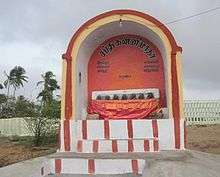
According to Leslie C. Orr, the Saptamatrika, who first appeared in South India in the eighth century, had once temples dedicated exclusively to them, but the ninth century onwards, they were demoted to status of "deities of the entourage" (parivara devata) of Shiva. Their images moved from the sanctums to corners of temple complexes and now they are as guardian deities in small village shrines.[94] The Saptamatrikas are worshipped as Saptakanyakas (the celestial nymphs) in most South Indian Shiva temples. But the Selliyamman temple at Alambakkam in Tiruchirapalli district (In 1909 called Trichonopoly district) is important in worship of the Matrikas. Here once stood a temple dedicated to the Saptamatrika, which was replaced by the present temple.[95][96]
In India, shrines of the Saptamatrikas are located in "the wilderness", usually near lakes or rivers, and are made of seven vermilion smeared stones. It is believed that the Matrikas kill fetuses and newborns unless pacified with bridal finery and prayers by women.[97] Devdutt Pattanaik says: "The cult of the Seven Mothers is found all over India. ... Pregnant women and nursing mothers worship them. When these goddesses are angry, they make women barren and strike newborns with fatal fevers. When they are appeased, they ensure the health and happiness of children."[98] A prominent Saptamatrika temple is located near Baitarani River, in Jajpur.
The Saptamatrika images are worshipped by women on Pithori – new moon day, with the 64 yoginis represented by rice flour images or supari nuts. The goddesses are worshipped by ceremonial offerings of fruit and flower and mantras.[99]
In Nepal
.jpg)
.jpg)
The Matrikas function both as city protectors and individual protectors in both Hinduism and Buddhism. The Astha matrika are considered as Ajimas (grandmother goddesses, who are feared as bringer of disease and misfortune as well act as protectresses) in the Newar pantheon. Temples (pithas i.e. seats) of the ashta matrika built in and around Kathmandu are considered powerful places of worship.[100]
The pithas are usually open-air shrines, but may be closed structures too. In these pithas, the Matrikas are worshipped with their followers (ganas) in form of stone statues or natural stones, while in dyochems (god-houses) in towns and villages, they are represented in brass images. The brass images (utsav-murtis) are paraded around town and placed at their respective pithas once every year. Like Vishnudharmottara Purana (discussed in Legends), the Matrikas are considered as representing a vice and are worshipped by pithapuja (a pilgrimage around the pithas) to free oneself from them.[101] Though each pitha is primarily dedicated to a Matrika, the other Matrikas are also worshipped as subordinate deities.[102] The pithas, which are "theoretically located at the outer boundaries of the city" are said to form a protective mandala around the city and assisted to a certain compass point.[103] In other temples like the ones dedicated to Pacali Bhairava, the Asthamatrikas are worshipped as a circle of stones.[102] In Bhaktapur, the Ashtamatrikas are believed to the preserver goddesses of the city guarding the eight geometrical directions. Mary Sluser says "Not only do the Mātṛkās guard the compass points but they are also regarded as regents of the sky."[104] Sometimes, they are paired with the Ashta Bhairava (Eight aspects of Bhairava) and sculpted on temple roofs or terraces. Nepali Buddhists worship the Matrikas as described in Dharanisamgrahas.[105]
The Malla king of Nepal Srinivasa Malla built the Patan durbar (court) in 1667 AD and is believed to have seen the Matrikas dance in the durbar one night. The king ordered that the Ashta-matrika be worshipped during the Ashwin Navaratri and cost is defrayed by the durbar. The custom continues til this day.[106] Another festival Ghorajatra is celebrated in Patan with animal sacrifices to the Matrikas.[107]
In the Kathmandu valley of Nepal, the Ashta-matrikas with a central village goddess are worshipped as protectors of the city or town. They are identified with the guardians of directions (digpala), places (lokapala) or lands (kshatrapala), satiated by blood sacrifice. Newar Buddhists associate the Matrikas with 24 human qualities, which can mastered by visiting three sets of eight Matrika pithas.[108]
Tantric worship
The 7th century Sanskrit author Banabhatta mentions the propitiation of Matrikas by a Tantric ascetic in his Harshacharita.[109] The text mentions use of māṭrmandala (mandala of the Matrikas) or Yantra along with a special anusthana (ritual) to cure the ailing king.[110] The text describes "young nobles [..](of the king) burning themselves with lamps to propitiate the Matrikas in a temple dedicated to the Matrikas (maṭṛ-gṛha). Banabhatta's Kadambari, Bhasa's Cārudatta, Shudraka's Mrichakatika mention the ritual offerings of food and shrines of Matrikas at crossroads.[34] Other offerings include flowers and clothes and meat and wine for some Matrikas. Tantric works like Tantrarāja-Tantra (unknown date, author) and Kulacūḍāmaṇi discuss the worship of Matrikas as Shaktis or letters of the alphabet.[111] A process of this worship, Matrika-nyasa (lit. "installation of the Mothers"), is described in Devi Gita, part of Devi Bhagavata Purana.[112] It involves installation of powers of Matrikas – as letters of the alphabet – in one's body, by "feeling the deity worshipped in different parts of the body" like head, face, anus and legs and reciting mantras.[113] The Hrillekha-matrika-nyasa, a more specialized form of Matrika-nyasa, combines the installation of "most powerful set of all letters (Matrikas)" with the seed syllable Hrīṃ of Goddess Bhuvaneshvari.[114]
Stone inscriptions of Tantric worship of The Matrikas are found in Gangadhar, Rajasthan(by king Vishvavarman- 423 C.E., identified as the first epigraphic evidence of Tantra worship); in Bihar (by Guptas – fifth century) and in Deogarh, Uttar Pradesh (by Svāmibhaṭa – sixth century).[34] The Gangadhar inscripture deals with a construction to a shrine to Chamunda and the other Matrikas, "who are attended by Dakinis (female demons)" and rituals of daily Tantric worship (Tantrobhuta) like the ritual of Bali (offering of grain).[110]
The eight Matrikas are said to reside the second line of bhupura in Sri Chakra. They are frequently aligned with the Eight Bhairavas, as in Jňānārṇava Tantra. The Svacchaṇḍa Tantra(1.33) explains that the primary function of Matrikas is to preside eight groups (vargas) of letters of Devanagari alphabet, while Brahmayāmala states they issue originate from the vowels.[115]
Rituals and goals of worship
The Natya Shastra (13.66) recommends worship to Matrikas before setting up the stage and before dance performances.[22] Indra declares in chapter 90 of Devi Purana that the Matrikas are the best among all deities and should be worshipped in cities, villages, towns and shields.[116] Matrikas are generally to be worshipped on all occasions with Navagraha (the nine planets) and the Dikpala (Guardians of the directions) and at night with the Goddess.[117]
The Matsya Purana and Devi Purana prescribe that Matrika shrines should be north-facing and be placed in northern part of a temple-complex.[118] The temples of the Matrikas are found earliest dating to the fourth century and from textual evidence, it is predicated that "there must be impressive shrines all over the [Indian] subcontinent".[119] Although circular Mandalas and Chakras are mentioned in religious texts, most existing shrines are rectangular in nature. Pal speculates that earlier circular shrines, which open to the sky or under trees of less durable material were replaced by the Guptas in stone as rectangular shrines.[74]
The Devi Purana mentions the Matrikas or Deva Shaktis (powers of the gods) as group of seven or more, who should be worshipped for Mukti (liberation) by all, but particularly kings for powers of domination.[75] The Saptamatrika are worshipped for "personal and spiritual renewal" with Mukti as the ultimate goal as well as for powers to control and rule and earthly desires (Bhukti).[120] Also important are the banners of the Saptamatrikas, which are carved outside the Udayagiri caves. These banners are called "Indra's sisters" in the Devi Purana. The Purana lists them as: swan, bull, peacock, conch, discus, elephant and skeleton – attributes of the Matrikas. A king installing these banners is believed to get mukti and bhukti. As per the Nitisara, Matrikas acted as the king's tangible Shaktis and conferred the power to conquer and rule.[121]
See also
Notes
- Wangu p.99
- Monier, Williams (1872). Sanskrit-English Dictionary. Clarendon. p. 765.
matrika.
- Leeming, David; Fee, Christopher (2016). The Goddess: Myths of the Great Mother. Reaktion Books.
- Berkson, Carmel (1992). Ellora, Concept and Style. Abhinav Publications. p. 134.
- "Mantras to the Aṣṭamātṛkās". http://cudl.lib.cam.ac.uk. Cambridge Digital Library. Retrieved 2 February 2015. External link in
|website=(help) - van den Hoek in Nas, p.362
- Wangu p.41
- Bhattacharyya, N. N., History of the Sakta Religion, Munshiram Manoharlal Publishers Pvt. Ltd. (New Delhi, 1974, 2d ed. 1996), p. 126.
- Wangu p.75
- Collins, Charles Dillard. The Iconography and Ritual of Śiva at Elephanta. Albany: State University of New York Press, 1988. p.143
- http://www.art-and-archaeology.com/india/jagat/jagat13.html
- Kinsley, David. Hindu Goddesses: Visions of the Divine Feminine in Hindu Religious Tradition. Berkeley: University of California Press, 1988. p.151
- Jain p.162
- Brhatsamhita, Ch.57, v.56. Panda, S.S. (September 2004). "Sakti Cult in Upper Mahanadi Valley" (PDF). Orissa Review. Government of Orissa. Archived from the original (PDF) on 2009-03-04. Retrieved 2008-01-08.
- Wangu Glossary p.187
- Jagdish Narain Tiwari, "Studies in Goddess Cults in Northern India, with Reference to the First Seven Centuries AD" p.215-244; as referred in Kinsley p.151
- Dilip Chakravati in Archaeology and World Religion By Timothy Insoll, Published 2001, Routledge, ISBN 0-415-22154-4, pp.42–44
- Kinsley p.151
- Pal in Singh p.1836
- Zimmer Heinrich, 1960,2001 The Art Of Indian Asia, Its Mythology and Transformations.Motilal Banarsidas Publication. New Delhi (Page B4C,257,135)
- Harper in Harper and Brown, p.48
- Kinsley, Hindu Goddesses, p.155
- Schastok, Sara L. The Śamalājī Sculptures and Sixth-Century Art in Western India. Leiden: Brill, 1985. pp.58–60
- Bhattacharyya, N. N., History of the Sakta Religion, Munshiram Manoharlal Publishers Pvt. Ltd. (New Delhi, 1974, 2d ed. 1996).
- Wangu pp.58–59
- Wangu p.67
- Wangu p. 68
- Wangu p.76
- Berkson p.212
- Kamath, Suryanath U. (2001) [1980]. A concise history of Karnataka : from pre-historic times to the present. Bangalore: Jupiter books. LCCN 80905179. OCLC 7796041. p51
- Kamath (2001), p52
- Goswami, Meghali; Gupta, Ila; Jha, P. (March 2005). "Sapta Matrikas In Indian Art and their significance in Indian Sculpture and Ethos: A Critical Study" (PDF). Anistoriton Journal. Anistoriton. Retrieved 2008-01-08.
- Dr. Suryanath U. Kamath (2001), A Concise History of Karnataka from pre-historic times to the present, Jupiter books, MCC (Reprinted 2002), p60
- Lorenzen, David in Harper and Brown, p.29
- Harper in Harper and Brown, p.121
- Kinsley p.156
- Cited in Laura Kristine Chamberlain. “Durga and the Dashain Harvest Festival: From the Indus to Kathmandu Valleys” in ReVision, Summer 2002, vol. 25, no. 1, p.26
- Agni Purana, Tr. by M.N. Dutta, Calcutta, 1903–04, Ch.50.18.22.
- See:
- Kinsley p.156, IAST Names and Descriptions as per Devi Mahatmya, verses 8.11–20
- "Sapta Matrikas (12th C AD)". Department of Archaeology and Museums, Government of Andhra Pradesh. Archived from the original on July 1, 2007. Retrieved 2008-01-08.
- Other names from Devi Purana: Pal in Singh p.1844 and Descriptions: p.1846
- Kalia, pp.106–109.
- Singh p.1840, Ambika is used as another name for Kaumari in Devi Purana.
- Kinsley p.241 Footnotes
- Wangu p.72
- Singh p.1858
- Kalia, p.108
- Pal in Singh p.1846
- The stories are quoted in (Rao, T.A. Gopinatha, Elements of Hindu Iconography, Vol.I, Part-II, 2nd Edition, Indological Book House, Varanasi, 1971, pp.379–383).
- Kinsley p. 156, Devi Mahatmya verses 8.11–20
- Kinsley p. 156, Devi Mahatmya verses 8.38, 44, 49, 62
- Kinsley p. 156, Devi Mahatmya verses 8.62
- Kinsley p. 156, verses 5.28–29 and It names 10 goddesses and then says that some shaktis of other gods also came to battle.
- Kinsley p. 156, verses 30
- Kinsley p.242
- Kinsley p. 158, Devi Mahatmya verses 10.2–5
- Kinsley p. 158, verses 30.3–9
- Kinsley p. 158-159, verses 179.8–90
- Pal in Singh p.1835-6
- Kinsley p. 159, verses 1.225
- Kinsley p. 159, verses 17.33–37
- Kinsley p. 159, Verses 44.1–96
- Kinsley p. 159, verses 2.10.37–39 and 10.63.6 ff., 10.6,27–29
- Pal in Singh p.1839
- Pal in Singh p.1835
- Pal in Singh p.1844
- Pal in Singh p.1840, Chapters 111–116
- Pal in Singh p.1840, Chapter 116(82–86)
- Mahabharata verses 215.16 – 215.18, two of the goddesses are described in 215.21–22
- Kinsley p.152
- Harper in Harper and Brown, p.116
- Kinsley p.153
- Pattanaik pp.132–3
- Vaishampayana said... The Mahabharata translated by Kisari Mohan Ganguli (1883 -1896), Book 9: Shalya Parva: Section 46.
- Kinsley p.154
- Singh p.1855
- Pal in Singh p.1858
- Harper in Harper and Brown, p.117
- Berkson p.87
- Berkson p.134
- For images see Berkson pp.136 – 144
- Berkson p.186
- Berkson pp.186–7
- Berkson p.135
- Kalia p.109
- Dehejia, Vidya, Yogini Cult and Temples
- Bhattacharyya, N. N., History of the Sakta Religion, Munshiram Manoharlal Publishers Pvt. Ltd. (New Delhi, 1974, 2d ed. 1996), p. 128.
- Wangu p.114
- Banerji p.296
- Cox, Colette (1992). "The unbroken treatise: Scripture and argument in early Buddhist scholasticism". In Williams, M.A.; Cox, C.; Jaffee, M. (eds.). Innovation in Religions Traditions: Essays in the Interpretation of Religions Change. de Gruyter. p. 152.
- Bühler, G. (1881). "Palaeographical remarks on the Horiuzi palm leaf MSS.". In Müller, F.M. (ed.). Anecdota Oxoniensia: Texts, Documents, and Extracts Chiefly from Manuscripts in the Bodleian and the Oxford Libraries. Clarendon Press. p. 67, note 2.
- Aryan (1980), p. 9
- Jain p.163
- Aryan (1980), pp. 24–28
- Woodroffe, p. 103
- Banerji p.61
- Leslie C. Orr, Gods and Worshippers on South Indian sacred ground in The World in the Year 1000 By James Heitzman and Wolfgang Schenkluhn, pp.244–5, Published 2004, University Press of America, 338 pages, ISBN 0-7618-2561-4.
- The Madras Epigraphical Department, Annual Report 1909-10 p. 285 as quoted in pp.285–6 South Indian shrines illustrated By P. V. Jagadisa Ayyar. Published 1993, Asian Educational Services,ISBN 81-206-0151-3
- Rajarajan, R.K.K. "Early Pāṇḍya Siṃhavāhinī and Sapta Mātṛkā Sculptures in the Far South of India". Cite journal requires
|journal=(help) - Pattanaik p.131
- "SaptaMatrikas and Matrikas". Shakti Sadhana Group. 27 March 2006. Retrieved 2008-01-08.
- The Hindu Religious Year By Muriel Marion Underhill; Published 1991; Asian Educational Services, 194 pages, ISBN 81-206-0523-3, p.110
- The Rough Guide to Nepal By David Reed, James McConnachie p.521 Published 2002 Rough Guides ISBN 1-85828-899-1
- van den Hoek, Bert in Nas, p.362
- van den Hoek, Bert in Nas, p.367-8
- van den Hoek, Bert in Nas, p.364
- White p.61
- Pal in Singh p.1851
- p.245 History of Nepal: With an Introductory Sketch of the Country and People of Nepal. By Daniel Wright Published 1996, Asian Educational Services,340 pages,ISBN 81-206-0552-7
- Nepal Handbook By Tom Woodhatch Published 1999 Footprint Travel Guides 572 pages ISBN 0-658-00016-0
- Hiltebeitel p. 260
- Banerji p.34
- Joshi, M.C. in Harper and Brown, p.48
- Banerji p.148 and 205
- Brown, p.292 Verses 10.6–8
- Banerji p.27
- Brown, p.293-4
- Brooks p.143-4
- Singh p.1850
- Singh p.1850-51
- Pal in Singh p.1850-1
- Pal in Singh p.1854
- Harper in Harper and Brown, p.122
- Harper in Harper and Brown, p.125-7
b. ^ Note that the Gupta rulers took the names of the deity Skanda as their own names
c. ^ This very ability is possessed by Raktabija of the Devi-mahatmya and Vamana Purana.
References
- Aryan, K.C. (1980). The Little Goddesses (Matrikas). New Delhi: Rekha Prakashan. ISBN 81-900002-7-6.
- Berkson, Carmel (1992). Ellora, Concept and Style. Abhinav Publications. ISBN 81-7017-277-2.
- Jain, Madhu; O. C. Handa (1995). The Abode of Mahashiva: Cults and Symbology in Jaunsar-Bawar in the Mid – Himalayas. Indus Publishing. ISBN 81-7387-030-6.
- Kinsley, David (1998) [1988]. Hindu Goddesses: Vision of the Divine Feminine in the Hindu Religious Traditions. Motilal Banarsidass. ISBN 81-208-0394-9.
- Panikkar, Shivaji K (1997). "Saptamatrka Worship and Sculptures: An Iconological Interpretation of Conflicts and Resolutions in the Storied Brahmanical Icons". Perspectives in Indian Art and Archaeology. 3 (1 ed.). ISBN 81-246-0074-0.
- Van den Hoek, Bert (1993). "Kathmandu as a sacrificial arena". In Nas, Peter J. M. (ed.). Urban Symbolism. BRILL. ISBN 90-04-09855-0.
- Wangu, Madhu Bazaz (2003). Images of Indian Goddesses. Abhinav Publications. ISBN 81-7017-416-3.
- Woodroffe, Sir John (2001). The Garland of Letters. Chennai, India: Ganesh & Co. ISBN 81-85988-12-9.
- Hiltebeitel, Alf. "Goddesses, place, Identity in Nepal". South Asian Folklore.
- Jain, Madhu; O. C. Handa (1995). The Abode of Mahashiva: Cults and Symbology in Jaunsar-Bawar in the Mid – Himalayas. Indus Publishing. ISBN 81-7387-030-6.
- Banerji, S.C., Companion to Tantra, Published 2002, Abhinav Publications, ISBN 81-7017-402-3.
- Harper, Katherine Anne and Brown, Robert L.; The Roots of Tantra; Published 2002; SUNY Press; ISBN 0-7914-5305-7
- Pattanaik, Devdutt; The Goddess in India: The Five Faces of the Eternal Feminine; Published 2000; Inner Traditions / Bear & Company; 176 pages; ISBN 0-89281-807-7
- Pal, P. The Mother Goddesses According to the Devipurana in Singh, Nagendra Kumar, Encyclopaedia of Hinduism, Published 1997, Anmol Publications PVT. LTD.,ISBN 81-7488-168-9
- Brooks, Douglas Renfrew. Auspicious Wisdom: The Texts and Traditions of Srividya Sakta Tantrism, 1992, SUNY Press, ISBN 0-7914-1145-1.
- Brown, Cheever Mackenzie. The Devi Gita: The Song of the Goddess: A Translation, Annotation, and Commentary , 1998, SUNY Press, 404 pages, ISBN 0-7914-3939-9.
- Kalia, Asha (1982). Art of Osian Temples: Socio-Economic and Religious Life in India, 8th–12th Centuries A.D. Abhinav Publications. ISBN 0-391-02558-9.
- Schastok, Sara L. (1985). The Śāmalājī Sculptures and 6th Century Art in Western India. BRILL. ISBN 90-04-06941-0
- Kiss of the Yogini: "Tantric Sex" in its South Asian Contexts By David Gordon White
- Dehejia, Vidya, Yogini Cult and Temples.
- Rajarajan, R.K.K. (2015) Early Pāṇḍya Siṁhavāhinī and Sapta Mātṛka Sculptures in the far South of India. Religions of South Asia. Equinox Publishing, Sheffield. Vol. 9.2: pp. 164–185. ISSN 1751-2689. doi:10.1558/rosa.v9i2.31071
External links
| Wikimedia Commons has media related to Matrika. |
- "Matrikas embedded in eight petals of the Kali Yantra: Image"
- "Translation of Devi Mahatmya passages that describe the Sapta matrika and Images"
- Article on "Tantric Hieroglyphics" (with emphasis on Matrkas)- Published in Quarterly Journal of Mythic Society by S. Srikanta Sastri
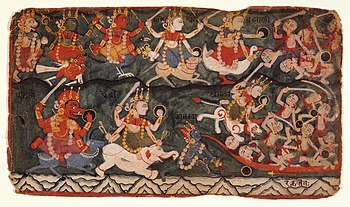
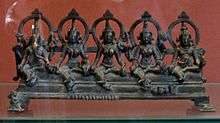
_in_Panchalingeshvara_Temple_at_Govindanahalli.jpg)
